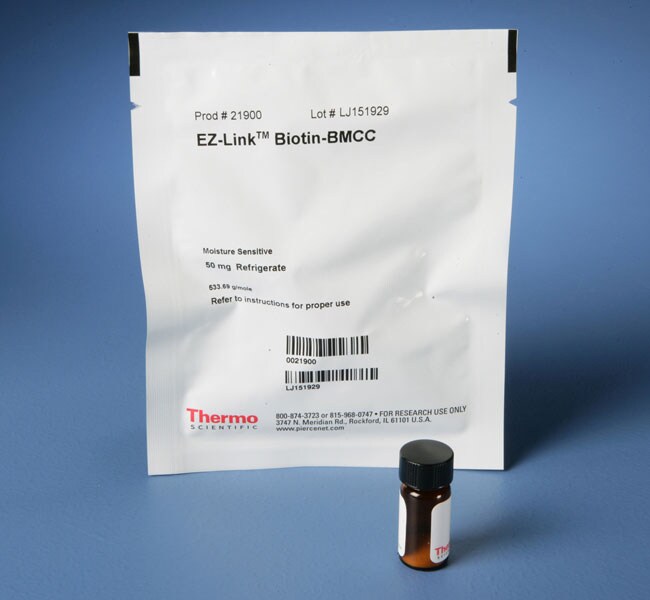Thermo Scientific EZ-Link BMCC-Biotin is a maleimide-activated, sulfhydryl-reactive biotinylation reagent with an extended spacer arm that contains a stabilizing cyclohexane group.
Features of EZ-Link BMCC-Biotin:
•
Protein labeling—biotinylate antibodies or other proteins for use in protein methods
•
Membrane-permeable—can be used to label inside cells (intracellular)
•
Thiol-reactive—reacts with sulfhydryls (-SH), such as the side-chain of cysteine (C)
•
Maleimide-activated—perform reactions at pH 6.5 to 7.5 in buffers such as PBS
•
Irreversible—forms permanent thioether bonds; spacer arm cannot be cleaved
•
Solubility—must be dissolved in DMSO or DMF before further dilution in aqueous buffers
•
Medium length—spacer arm (total length added to target) is 32.6 angstroms; contains cyclohexane ring, which stabilizes adjacent maleimide
BMCC-Biotin is a maleimido-biotin compound for labeling protein cysteines and other molecules that contain sulfhydryl groups. This reagent specifically reacts with reduced thiols (-SH) in near-neutral buffers to form permanent (irreversible) thioether bonds. The unique feature of BMCC-Biotin is its spacer arm cyclohexane ring; this has a stabilizing effect that minimizes hydrolysis and degradation of the maleimide group until it has opportunity to conjugate with target thiols.
We manufacture biotin reagents to ensure the highest possible overall product integrity, consistency and performance for the intended research applications.
Biotinylation reagents differ in reactivity, length, solubility, cell permeability and cleavability. Three
types of sulfhydryl-reactive compounds are available: maleimido, iodoacetyl and pyridyldithiol. Maleimide reagents specifically react with sulfhydryl groups (-SH) in near-neutral buffers to form permanent thioether bonds.
In proteins, sulfhydryls exist where there are cysteine (C) residues. Cystine disulfide bonds must be reduced to make sulfhydryl groups available for labeling. Hinge-region disulfide bridges of antibodies can be selectively reduced to make functional half-antibodies that can be labeled.
For Research Use Only. Not for use in diagnostic procedures.
